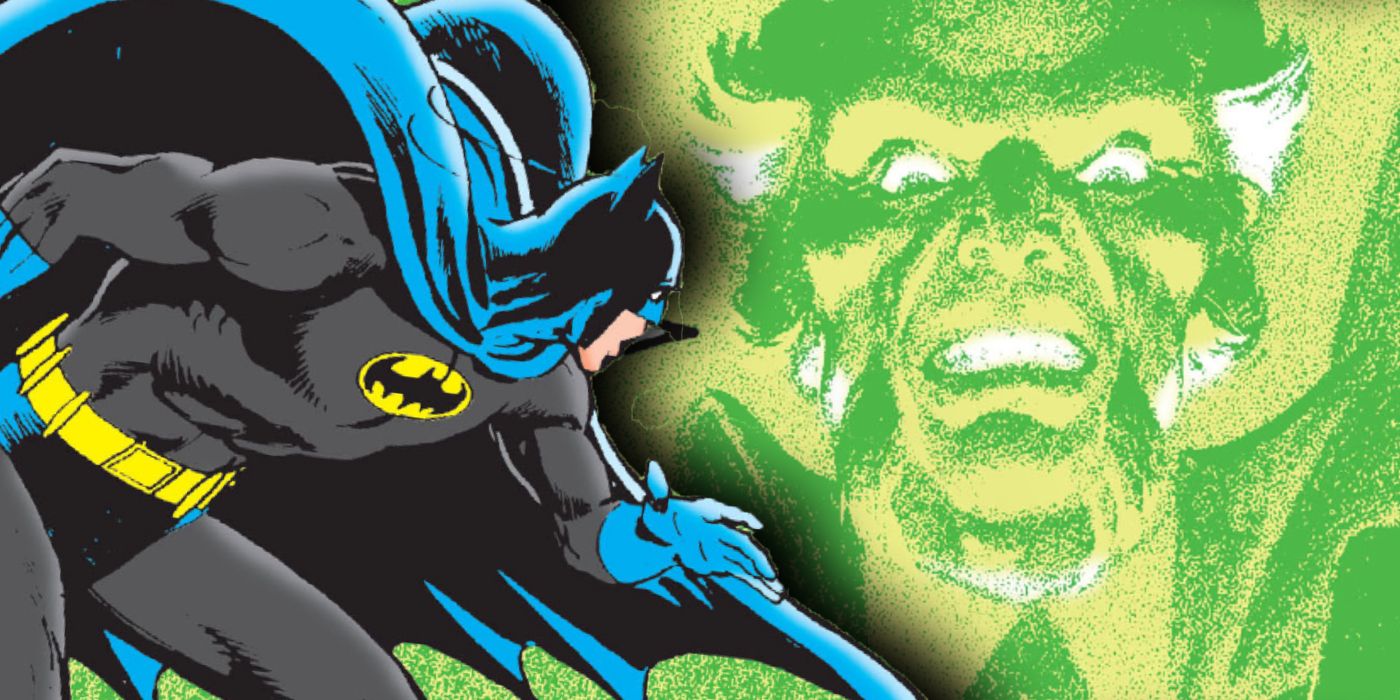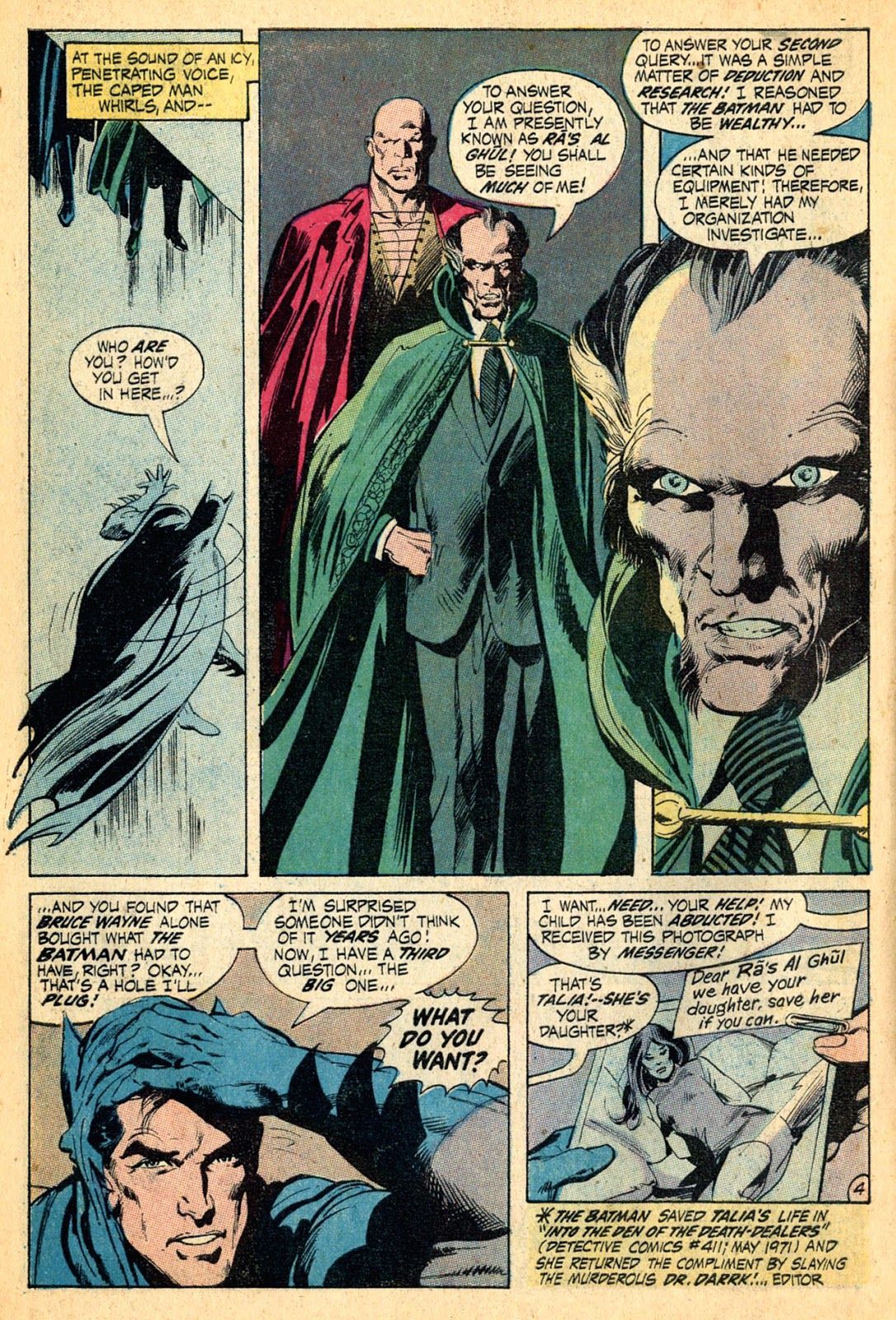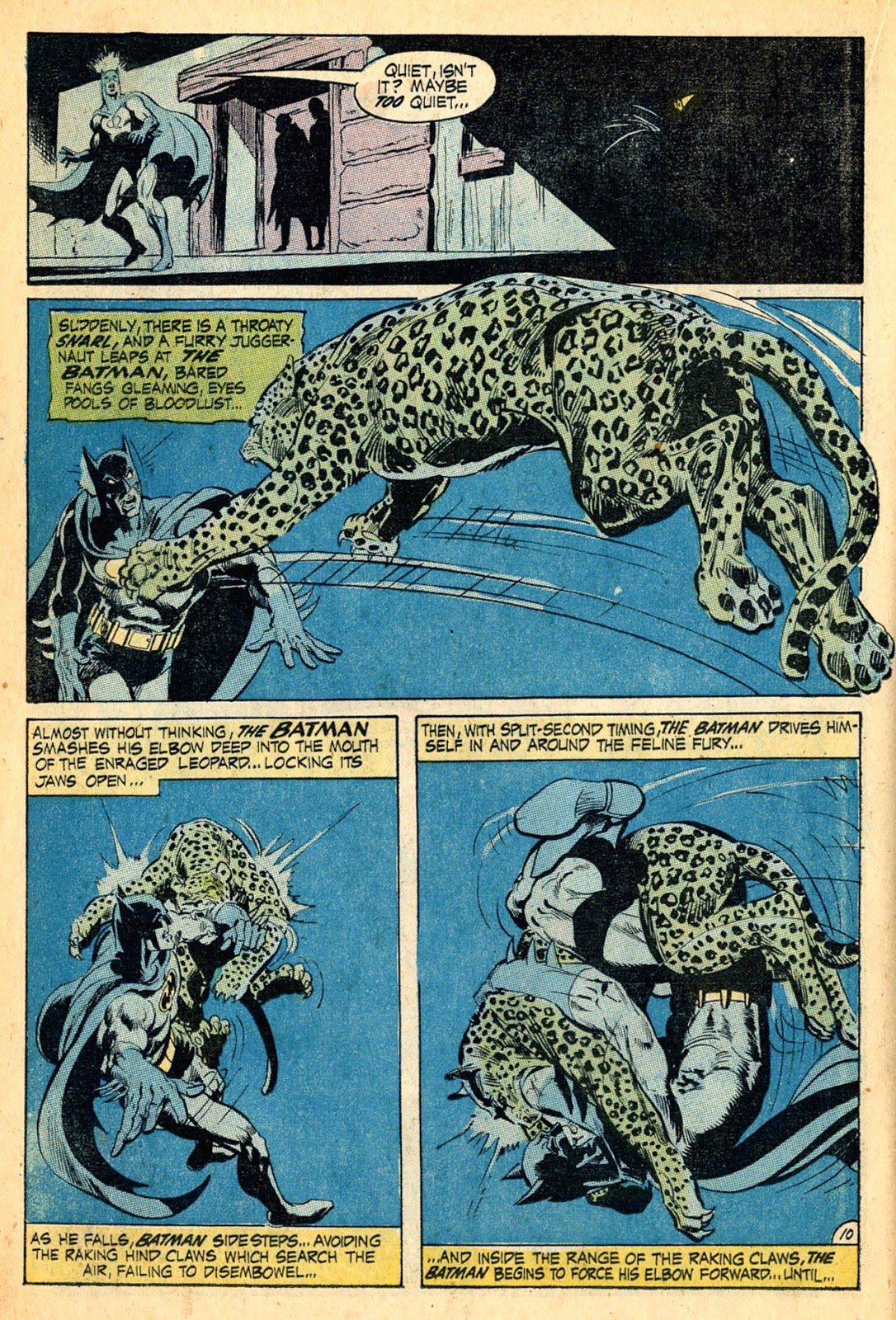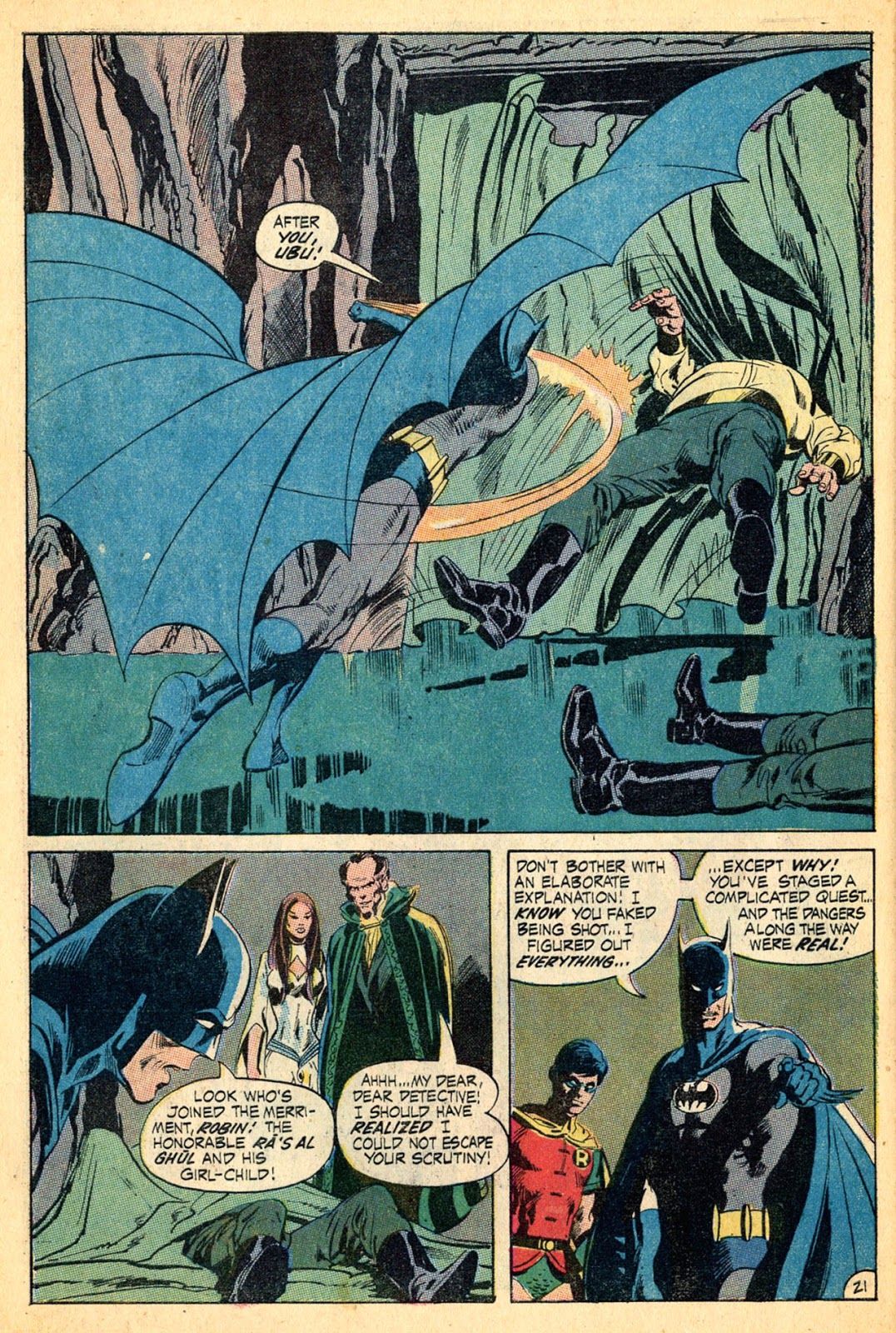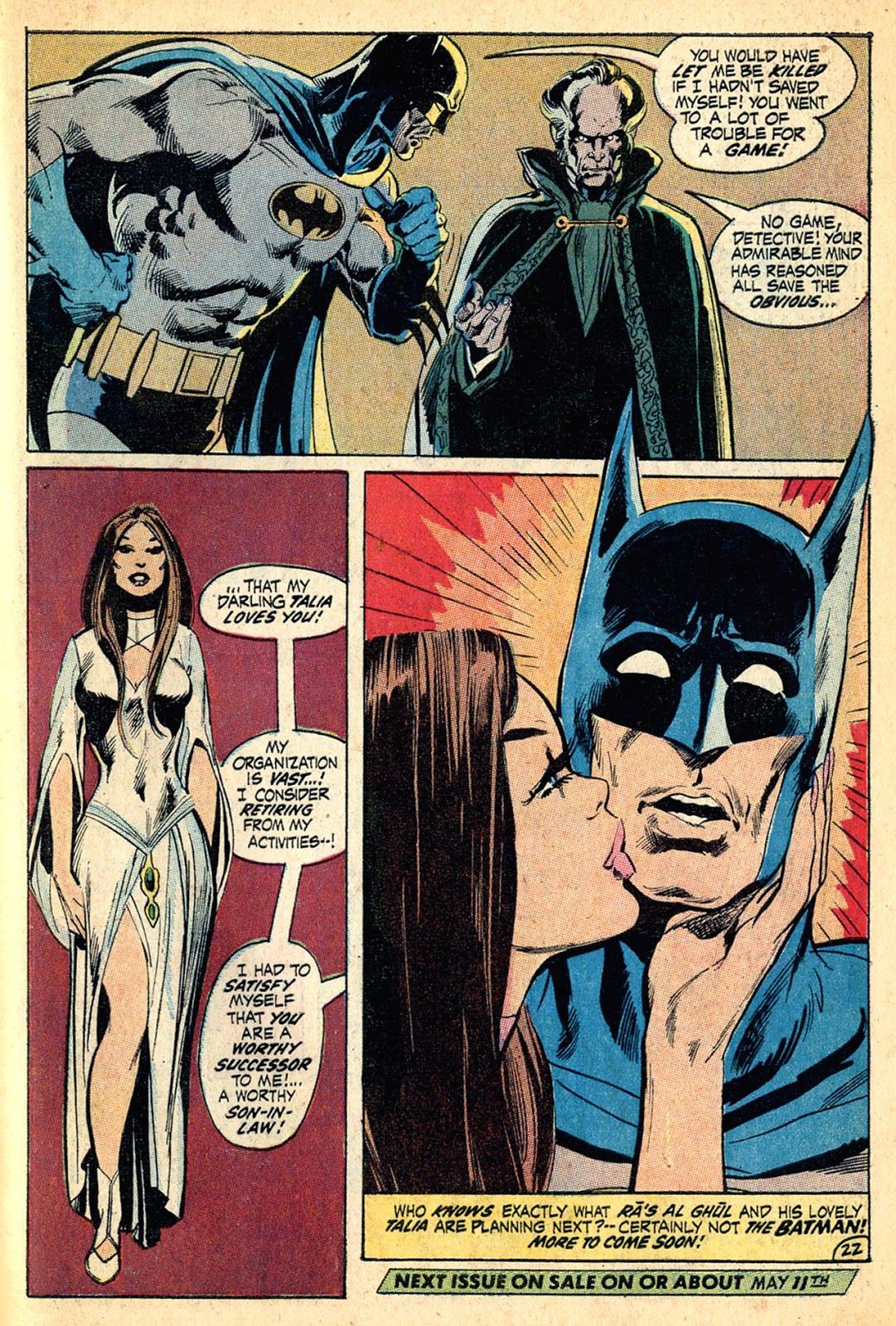Today, we look back to 1971 for the debut of Ra's Al Ghul in Batman #232, as we learn two very different (but reconcilable) origins for the character's creation.
This is "Look Back,". The concept is that every four weeks of a month, I will spotlight a single issue of a comic book that came out in the past and talk about that issue (often in terms of a larger scale, like the series overall, etc.). Each spotlight will be a look at a comic book from a different year that came out the same month X amount of years ago. The first spotlight of the month looks at a book that came out this month ten years ago. The second spotlight looks at a book that came out this month 25 years ago. The third spotlight looks at a book that came out this month 50 years ago. The fourth spotlight looks at a book that came out this month 75 years ago. The occasional fifth week (we look at weeks broadly, so if a month has either five Sundays or five Saturdays, it counts as having a fifth week) looks at books from 20/30/40/60/70/80 years ago.
RA'S MAKES HIS DEBUT
When last I looked at a 1971 adventure, it was the introduction of Talia, the daughter of Ra's al Ghul, but as I noted when discussing that issue, it was clear that Talia's introduction was designed as a precursor to the introduction of her father, as Ra's is name-checked in that story. I don't know about you, but when a villain specifically gets name-checked before they even debut, I tend to think that that villain is going to turn out to be someone pretty interesting (of course, I'm sure I could think of about twelve different exceptions to that notion if I gave it time).
In April 1971's Batman #232, by Denny O'Neil, Neal Adams and Dick Giordano, Robin is shockingly shot at the beginning of the issue. Batman is then sent a photo of his kidnapped partner and then is disturbed by Ra's al Ghul, who is so badass that he even discovered Batman's secret identity. He wants to work with Batman as he has also received a photo of his kidnapped daughter, Talia...
This then kickstarts a search for the missing Talia and Robin, with Batman, Ra's and Ra's servant, Ubu, traveling the globe and encountering a number of dangers, like an attack by a tiger (O'Neil cleverly puts a clue as to what is really going on in this attack by the tiger)...
You see, Batman quickly realizes that Ubu typically insists that he and his master walk ahead of Batman, except for a few occasions, and those occasions are where Batman runs into danger, so Batman figures out that this has all been a test. He goes along with it to get to Robin, but once he is reunited with his partner, they turn on Ra's and Ubu, with the Dark Knight taking the giant down...
While Ra's admits to the deception, he reveals that the real reason for this whole charade is that Talia has fallen in love with the Caped Crusader and Ra's wanted to test his mettle to see if Batman was a worthy partner for his daughter. In the end, Ra's approves, but does Batman? The plot is mostly dropped until it gets picked up for the future epic storyline where we first learn about the Lazarus Pit (and where Batman has one of his most defining moments of the 1970s)...
While that was the excellent introduction of Ra's, the interesting question is how did Ra's come to be? There are two different takes on his origin, but I think they reconcile with each other very well.
DENNY O'NEIL'S VERSION OF RA'S AL GHUL'S CREATION
The late O'Neil was interviewed by Ricky Church back in 2019 and it's interesting that when asked about Ra's origins, O'Neil even noted that he and Adams differ on the story of his creation. Here's what O'Neil had to say:
Well here we’re moving into territory where Neal would give you different answers than I will, but I can speak with some authority about Ra’s because I was really, literally there at the beginning. Julie Schwartz and I decided we needed a new major villain for Batman. We had gone back to the well too often. There was The Riddler, The Penguin and The Joker and we kept using those characters so Juliu had a name he liked. Ra’s al Ghul. It means ‘Head of the Demon’ in Arabic. I don’t know where he got it. So he gave me that and my mission was to create a character. You begin with your hero. What is Batman about? He’s about logic, about double identities, about Gotham City. So you think of a villain that speaks to all those and is also smarter and tougher than the hero. Later, when Ra’s became a movie star, I was made aware of similarities between him and Fu Manchu. Now I would have sworn I created Ra’s from nothing, but journalists have pointed out the similarities. I know I didn’t read any of the Fu Manchu novels. Did I see any of the movies? Well I used to go to a lot of 42nd Street movies and not always sober so it’s possible.
But he’s the only character I can think of where we set out to create a major character.
NEAL ADAMS' VERSION OF RA'S AL GHUL'S CREATION
Adams, for his part, discussed Ra's creation at a comic convention Q&A (Justin Francoeur asked the question and then posted the answers on his excellent DC in the 80s site):
The idea of Ra's Al Ghul is a little bit different. I was doing Batman with Denny O'Neil for Julius Schwartz, and [we] were trying NOT to do clowns, because basically -- you see, you guys don't necessarily know this because you're not old enough to know this -- Batman and his villains come from Dick Tracy. Dick Tracy had all these [villains]... Prune Face, Flat Top, The Blank... so when Bob Kane and Bill Finger were doing Batman, basically they stole the ideas of these crazy-weird guys from Dick Tracy. So we get the Mad Hatter, the Joker, the Penguin and all these kinda off-beat characters. A little hard to believe that a real Batman would be fighting these guys -- but you believed it with Dick Tracy, so why not Batman?
So when Denny and I picked up doing Batman, the question was: do we bring in the clowns? Not to begin with. So we didn't at the beginning, but we knew that sooner or later we were going to HAVE to. I went to Julie [aka Julius Schwartz] and told him that Batman needs a Moriarty. Julie said "what do you mean?" and I explained that we were going to start doing the Joker and the Riddler and the Two-Face, and we NEED a Moriarty. We need a real villain that's AS GOOD as Batman, because Sherlock Holmes -- the greatest detective in the world -- had Moriarty. As we all know. And he did well by him, if it wasn't for Moriarty, who knows if we would've had a successful Sherlock Holmes? We NEEDED one. Julie said "let me think about that".
Julie came in on Monday and said "Ra's Al Ghul!" My reaction: "What does that mean?" He replied "It means that's your new villain. It translates to 'Head of the Demon' in arabic. It's up to you to figure out what he looks like." So I did. That was my job. He looks sorta like Jack Palance if you shaved his head back a little bit. Do you know who Jack Palance is? Evil, evil actor. A wonderful evil actor -- for those of you who are old enough to know: when Jack Palance came on the screen you'd start to shudder. His eyes were close together and sunken in his head -- just a horrible-looking guy. He was the villain in 1953's Shane. So that was Ra's Al Ghul. It launched Batman with a NEW villain, and then we can bring in the clowns, because there was always Ra's Al Ghul lying in the background.
Honestly, as I noted earlier, the two versions can be reconciled pretty easily if you assume that Adams discussed things with Schwartz separately with Schwartz's discussions with O'Neil. Is that actually how it happened? I have no idea, maybe one or both of O'Neil and Adams are remembering wrong, but I think it's fair enough to just say they're both remembering things correctly and were just in parallel to each other.
If you folks have any suggestions for May (or any other later months) 2011, 1996, 1971 and 1946 comic books for me to spotlight, drop me a line at brianc@cbr.com! Here is the guide, though, for the cover dates of books so that you can make suggestions for books that actually came out in the correct month. Generally speaking, the traditional amount of time between the cover date and the release date of a comic book throughout most of comic history has been two months (it was three months at times, but not during the times we're discussing here). So the comic books will have a cover date that is two months ahead of the actual release date (so October for a book that came out in August). Obviously, it is easier to tell when a book from 10 years ago was released, since there was internet coverage of books back then.

